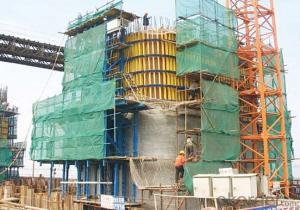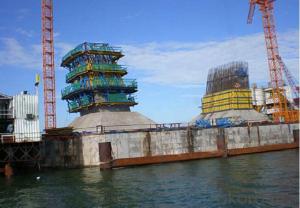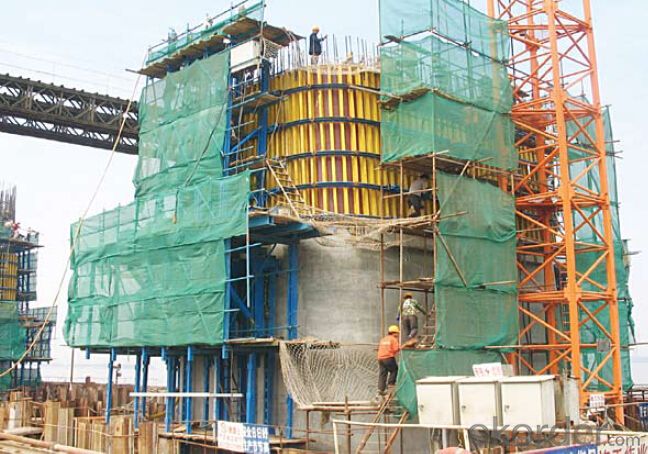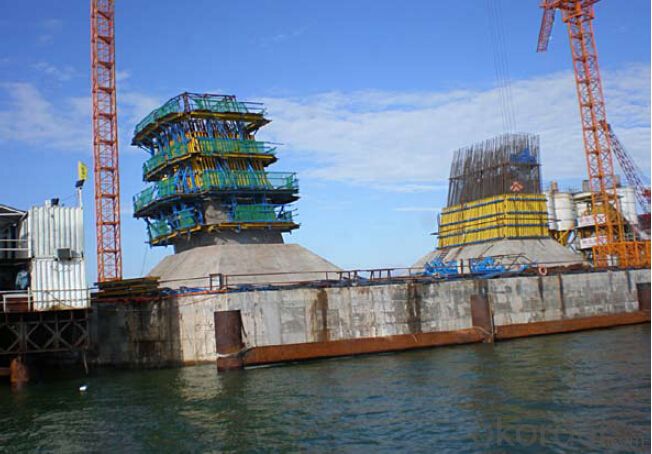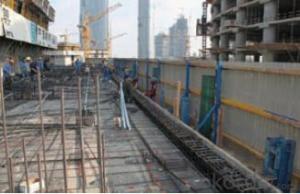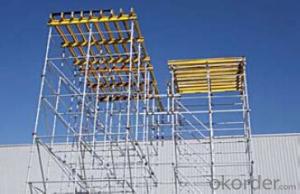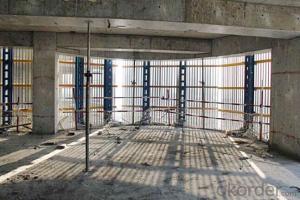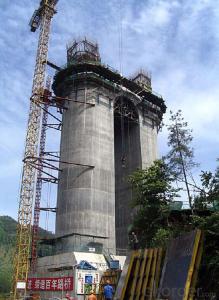Auto-Climbing bracket ACB100 for formwork and scaffolding system
- Loading Port:
- Tianjin
- Payment Terms:
- TT OR LC
- Min Order Qty:
- 50 m²
- Supply Capability:
- 1000 m²/month
OKorder Service Pledge
OKorder Financial Service
You Might Also Like
Auto-climbing Bracket ACB100 & ACB50
The power of the auto-climbing formwork is the hydraulic system, which includes the oil cylinder
and two commutators. The commutators can control the climbing of climbing rail and the bracket.
The steel rail and the bracket can inter-climbing, so the whole system will climb up steadily.
Cranes are not needed during the construction. It’s easy to operate, highly efficient and safe. It’s
the best choice for the construction of high buildings and bridges.
There are mainly two types of standard auto-climbing brackets, ACB-50 and ACB-100, the figure
means the push power of cylinder with unit of KN.
Characteristics:
◆ Perfect load bearing anchor system
Anchor system is the most important supporting part. The system is made of five parts shown
below. Thereinto, tensile bolt, V-climbing cone and washer can be taken out for reusing after the
concrete pouring finished.There are two kinds of anchor systems,A & B. A is matched with single
anchor shoe and B is matched with double anchor shoe.
◆ Crane-independent
Crane-independent forming, striking and climbing speeds up the work procedures on the
construction site and also makes them independent of each other. This means the planned
sequences can be maintained along with guaranteeing high productivity levels. The crane can
therefore be used for other tasks.
Hydraulic system is mainly made of two commutators,
oil cylinder and power distribution system.The
commutators can control the climbing of climbing rail
and bracket.
◆ High bearing capacity and safe
The stable working platforms are able to carry large loads, e.g. the storage of reinforcing steel
for the next climbing section. Generously-sized working platforms, the well thought-out design for
handling very high wind loads and the patented control function of the climbing mechanism are
some of the special details contained within the comprehensive safety concept.
◆ Platforms adjusted to suit the angle of inclination
The horizontal working areas thus created provide safe and comfortable conditions for
reinforcement work, shuttering and striking, concreting and finishing.
◆ The ACB formwork system can climb not only vertically but also slantways, the largest angle is
18 degrees.
◆ The system can climb up wholly or separately. The climbing process is steady, synchronous
and safe.
◆ The bracket will not fall to the ground until the construction is finished, the field will be saved
and the impacting breakage will be reduced (especially the panel).
◆ The system will furnish omnidirectional platform, the construction organizations don’t need to
set up additional operation platform.
◆ The error of structure construction is small and easy to correct.
◆ The climbing speed is fast, the construction course will be quickened.
◆ The formwork can climb itself and cleaning work can be done in the same situs , the used times
of tower crane will be greatly reduced.
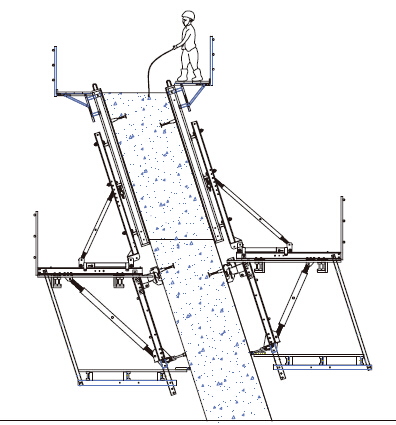
- Q: Is steel formwork suitable for projects with limited access?
- Yes, steel formwork can be suitable for projects with limited access. Steel formwork is known for its high strength and durability, allowing it to withstand the challenges of a project with limited access. It can be easily transported and assembled in confined spaces, making it a favorable choice for projects where access is restricted. Additionally, steel formwork can be easily dismantled and reused, which is beneficial in limited access situations where materials need to be transported in and out efficiently. The flexibility and adaptability of steel formwork make it a viable option for projects with restricted access.
- Q: What are the different types of steel formwork available?
- There are several types of steel formwork available, including traditional steel formwork, modular steel formwork, and tunnel formwork. Traditional steel formwork consists of steel panels that are assembled on-site and can be used repeatedly. Modular steel formwork is prefabricated and can be easily assembled and disassembled, making it more efficient and cost-effective. Tunnel formwork is specifically designed for the construction of tunnel structures and is made of steel plates that are interconnected to form a continuous wall.
- Q: What are the common quality control measures for steel formwork?
- Steel formwork undergoes several quality control measures to ensure its compliance with standards and specifications: 1. Thoroughly inspect the steel formwork for visible defects or damage, such as cracks, dents, or deformations, and address them accordingly. 2. Measure the dimensions of the steel formwork, including length, width, and height, and compare them to the specified requirements. Correct any deviations from the required dimensions. 3. Conduct material testing to verify that the steel formwork meets the necessary standards and specifications. This includes testing its tensile strength, yield strength, hardness, and chemical composition. 4. Inspect the quality of welds if the steel formwork is welded. Check for proper penetration, fusion, and the absence of defects like cracks or porosity. Employ non-destructive testing methods like ultrasonic or radiographic testing to ensure the integrity of the welds. 5. Inspect the surface coating, such as paint or galvanized coating, for thickness, adhesion, and uniformity. This guarantees protection against corrosion and enhances the durability of the formwork. 6. Subject the steel formwork to load testing to evaluate its structural integrity and load-bearing capacity. Apply a known load and monitor the formwork's response to ensure it can safely support the required loads during construction. 7. Document and maintain records of the quality control measures for future reference. This includes recording inspection results, material test reports, and any corrective actions taken. By implementing these quality control measures, the steel formwork can meet the necessary standards, specifications, and safety regulations, ensuring its structural integrity and performance during construction.
- Q: Can steel formwork be used for theater construction projects?
- The utilization of steel formwork is applicable to theater construction projects. Steel formwork is composed of temporary or permanent molds constructed from steel, which are employed to mold and support concrete during the construction phase. It is a highly adaptable and long-lasting material that can be utilized for various construction endeavors, including theater construction. The utilization of steel formwork presents several advantages for theater construction projects. Firstly, it provides a considerable amount of strength and stability, guaranteeing that the concrete structures created for theaters are robust and durable. This is of utmost importance in theaters, where safety is a primary concern due to the large gatherings of individuals in these spaces. Furthermore, steel formwork permits the achievement of intricate and complex designs, which are often necessary for theater construction. The malleability of steel formwork enables the creation of personalized shapes, curves, and patterns, enabling architects and designers to bring their innovative visions to fruition. Additionally, steel formwork is reusable, thus making it a cost-effective option for theater construction projects. In contrast to traditional wooden formwork, which must be replaced after a single use, steel formwork can be employed multiple times, resulting in reduced material and labor expenses. Lastly, steel formwork facilitates a faster construction process. Its simple assembly and disassembly hasten the construction timeline, allowing theater projects to be completed within a shorter timeframe. In conclusion, steel formwork is a suitable selection for theater construction projects due to its strength, adaptability, flexibility, reusability, and efficiency. It offers numerous benefits that contribute to the successful and timely completion of theater construction projects.
- Q: How does steel formwork affect the overall construction site safety measures?
- The overall construction site safety measures can be significantly impacted by steel formwork in various ways. To start with, the high strength and durability of steel formwork ensure stability and structural integrity during construction, thus reducing the risk of accidents like collapses or structural failures. This, in turn, enhances the safety of workers and the entire site. Moreover, steel formwork offers superior fire resistance compared to other formwork materials. This characteristic helps prevent or slow down the spread of fire, allowing workers enough time to evacuate the site safely and enabling emergency services to respond effectively. It also decreases the chances of fire-related accidents, safeguarding both human lives and the surrounding environment. Another safety advantage of steel formwork lies in its ability to withstand extreme weather conditions such as strong winds or heavy rain. This resilience lowers the likelihood of formwork damage or failure, ensuring worker safety and preventing potential accidents caused by adverse weather. Furthermore, steel formwork is often designed with integrated safety features like handrails and platforms to provide secure working surfaces for construction workers. These features enable workers to perform their tasks safely at heights, reducing the risk of falls and injuries. Lastly, steel formwork is reusable and requires minimal maintenance, contributing to overall site safety. The use of reusable formwork minimizes waste and clutter, resulting in a cleaner and more organized working environment. This, in turn, reduces the risk of accidents caused by tripping or falling over debris. In conclusion, steel formwork positively impacts construction site safety measures by providing stability, fire resistance, weather resistance, built-in safety features, and a cleaner working environment. These benefits reduce the risk of accidents, ensure worker safety, and contribute to the successful completion of construction projects.
- Q: What are the different types of formwork spacers used in steel formwork?
- In steel formwork, there are various types of formwork spacers that are commonly used. These spacers are essential components in the construction process as they help maintain the desired spacing between the formwork and reinforcement, ensuring the structural integrity of the concrete structure. Here are some of the different types of formwork spacers used in steel formwork: 1. Plastic Spacers: Plastic spacers are widely used in steel formwork due to their lightweight, durability, and ease of installation. These spacers are typically made from high-quality plastic materials and come in various shapes and sizes to accommodate different reinforcement requirements. 2. Steel Spacers: Steel spacers are another common type of formwork spacer used in steel formwork applications. They are usually made from high-strength steel and are capable of withstanding higher loads. Steel spacers are ideal for heavy-duty applications where additional strength and durability are required. 3. Rubber Spacers: Rubber spacers are used in steel formwork to provide a cushioning effect and prevent direct contact between the reinforcement and the formwork. These spacers are suitable for applications where vibration or movement is expected, as they help absorb shocks and reduce the risk of damage. 4. Concrete Spacers: Concrete spacers are primarily used in precast concrete applications. They are made from concrete and act as support structures to maintain the correct spacing between the formwork and reinforcement. Concrete spacers are durable, easy to install, and provide excellent stability during the casting process. 5. Combination Spacers: Combination spacers are versatile spacers that combine different materials such as plastic and steel to provide enhanced strength and stability. These spacers are designed to meet specific project requirements and offer a cost-effective solution for various steel formwork applications. It is important to choose the appropriate type of formwork spacer based on the specific requirements of the project, including load capacity, spacing requirements, and environmental conditions. Consulting with a structural engineer or construction professional can help ensure the correct selection and installation of formwork spacers for optimal performance and safety.
- Q: How does steel formwork perform in earthquake-prone areas?
- Due to its strength and durability, steel formwork is highly suitable for earthquake-prone areas. The material's resilience allows it to withstand the forces generated during seismic activity, and its excellent tensile strength enables it to resist bending and deformation. In order to ensure stability and safety in earthquake-prone regions, it is crucial to utilize reliable construction methods. Steel formwork provides a robust solution for constructing reinforced concrete structures that can withstand seismic activity. Its stability and rigidity contribute to the structural integrity of concrete elements, even in the face of strong ground shaking. In addition to its reliability, steel formwork offers flexibility in design and construction. It can easily be adjusted or modified to meet architectural and engineering requirements, which is particularly advantageous in areas where seismic resilience is a priority. Another benefit of steel formwork in earthquake-prone areas is its reusability. Being able to dismantle and reuse the formwork multiple times makes it a cost-effective and sustainable choice, which is especially valuable in regions with frequent seismic activity. Furthermore, steel formwork allows for better control over the quality of concrete structures. It helps achieve precise dimensions, shape, and surface finish, all of which are essential for seismic performance. The accuracy and consistency provided by steel formwork contribute to overall structural stability and reduce the risk of failure during earthquakes. Nevertheless, it is important to acknowledge that the effectiveness of steel formwork in earthquake-prone areas also relies on proper engineering design, construction techniques, and adherence to building codes and regulations. Collaborating with experienced professionals, including structural engineers, architects, and construction experts, is vital to ensure the successful utilization of steel formwork in earthquake-resistant construction.
- Q: How does steel formwork handle different concrete mix designs?
- Steel formwork is highly versatile and can easily handle different concrete mix designs. Its strength and durability allow it to withstand the pressure exerted by different concrete compositions. Additionally, steel formwork provides a smooth and even surface, ensuring that the concrete is properly shaped and cured. Its adaptability makes it suitable for a wide range of concrete mix designs, enabling construction projects to effectively accommodate various specifications and requirements.
- Q: How does steel formwork handle different concrete shrinkage characteristics?
- Steel formwork is a versatile and durable option for concrete construction projects, and it is designed to handle different concrete shrinkage characteristics effectively. Concrete shrinkage refers to the reduction in volume of the concrete as it dries and hardens. One of the main advantages of steel formwork is its strength and rigidity. Steel is a highly robust material that can withstand the pressure and forces exerted by the shrinking concrete. This ensures that the formwork remains intact and stable during the entire curing process, regardless of the concrete's shrinkage characteristics. Additionally, steel formwork is highly adjustable and can be easily modified to accommodate different concrete shrinkage rates. This flexibility allows contractors to adapt the formwork system to the specific needs of the project, ensuring that any potential issues related to shrinkage are effectively addressed. Moreover, steel formwork provides excellent support for the concrete during the curing process, minimizing the risk of cracking or deformation caused by shrinkage. Its smooth and non-absorbent surface helps to prevent excessive moisture loss from the concrete, which can contribute to increased shrinkage. By maintaining a controlled environment, steel formwork helps to regulate the drying process and reduce the overall shrinkage of the concrete. In summary, steel formwork is well-suited to handle different concrete shrinkage characteristics due to its strength, adjustability, and ability to provide optimal support and moisture control. This makes it a reliable and efficient choice for concrete construction projects, ensuring the integrity and longevity of the structure.
- Q: How does steel formwork affect the overall aesthetics of a construction project?
- The overall aesthetics of a construction project can be significantly influenced by steel formwork. Unlike traditional timber formwork, steel formwork offers a modern and sleek look that enhances the visual appeal of a structure. The clean lines and smooth surfaces achieved with steel formwork give a building a polished and sophisticated appearance. Moreover, steel formwork allows for greater precision and accuracy in shaping concrete, resulting in a more seamless and uniform finish. This is particularly important in architectural designs that require intricate or complex shapes. By using steel formwork, the concrete is poured exactly as intended, resulting in a more visually appealing end result. Furthermore, steel formwork is highly durable and resistant to wear and tear. It does not warp or deform over time, maintaining its structural integrity and aesthetic appeal for a longer period. This durability contributes to the longevity and overall quality of a construction project, making it a more attractive investment for owners and potential buyers. Another advantage of steel formwork is its adaptability. Steel can be easily molded and shaped into various sizes and configurations, allowing for greater design flexibility. This versatility empowers architects and designers to create unique and eye-catching structures that stand out from the rest. In conclusion, the use of steel formwork in a construction project has a positive impact on its overall aesthetics. Its sleek appearance, precise shaping capabilities, durability, and design flexibility all contribute to a visually appealing end result. Steel formwork enhances the architectural design, creates a polished finish, and increases the longevity and value of the structure.
Send your message to us
Auto-Climbing bracket ACB100 for formwork and scaffolding system
- Loading Port:
- Tianjin
- Payment Terms:
- TT OR LC
- Min Order Qty:
- 50 m²
- Supply Capability:
- 1000 m²/month
OKorder Service Pledge
OKorder Financial Service
Similar products
Hot products
Hot Searches
